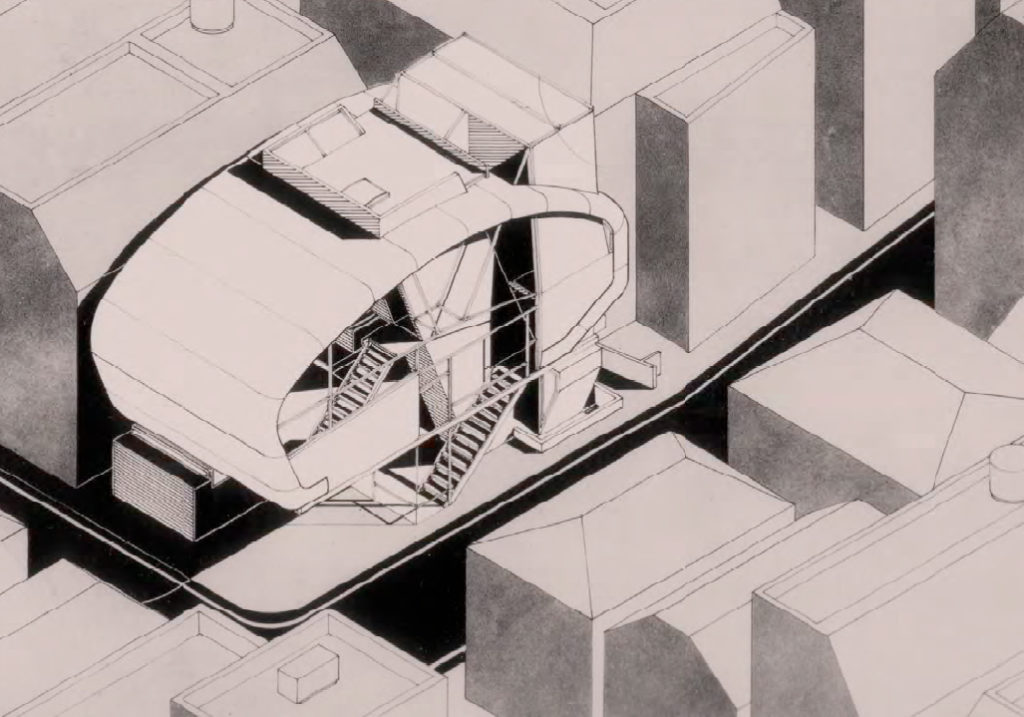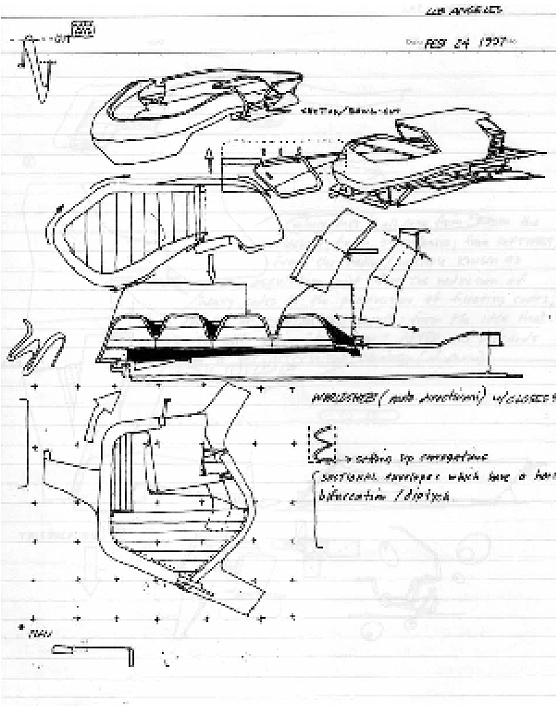
This short essay was written after an interview with Neil Denari that took place on June 4, 2005. Rather than explaining Denari’s work or quoting his words verbatim, the essay addresses a specific comment Denari made during the interview on drawing as illustration and attempts to extrapolate the notion of illustration in architecture. I am grateful to Neil Denari for his generosity with his time.
Neil Denari calls his drawings illustrations. Images in a book, a manual, a newspaper, or a magazine are illustrations; hence, the medium where the image is found plays a role in determining how an illustration works. A diagram, a cartoon, a graph are illustrations; hence, the kind of image plays a role in determining what an illustration is. What place does an illustration hold between drawing and design in architecture? What kind of a practice does it entail?
As Mario Carpo has shown, the introduction of images into architectural treatises in the Renaissance, concurrent with the invention of movable type, made an enormous impact on architecture.1 The volatile category called “illustration” implied not only the mechanical reproduction of drawings, but also a transformation in the production of architecture. Alberti, for instance, preferred to translate images into text and avoided visualization. With his distrust for illustrations at the dawn of mechanical reproduction, he devised a method for the notation and reproduction of three dimensional shapes based on numeration rather than visualization.2 He claimed that with his method, identical copies could be produced; two sculptors separated by distance or time could produce the two halves of a sculpture which would form a complete whole if brought together. Already implied in Alberti’s work was the practice of the architect as the writer of codes as opposed to an illustrator.
In Alberti’s case, the resistance to illustrations was founded on a criterion of precision. Prior to the intrusion of illustrations, written codes and sequences of operations were considered to be more precise for the transmission of architecture than an image. Hence, the adjacency of the two terms “precision” and “optical” was not an easy coupling; rather it was an acculturation that developed over a period of time in various fields. Art historian Svetlana Alpers has described the beginnings of this adjacency as the “art of describing,” in relation to a set of practices from mapping to projection.3 When Marcel Duchamp coined his own “precision optics,” the two terms were meshed onto each other in the world of visualizations.4 Duchamp, himself a student of technical drawings, played with the situation of illustration between drawing and design, between image and concept. In the set of rotating drawings named “rotoreliefs,” he relocated precision in the corporality of vision.
What, Exactly, Is an Illustrator’s Practice?
Illustration always has an end beyond itself. It illustrates something other than itself, and it can never be found outside media—be it a book, a magazine or a newspaper; or independent of its referent—be it a text or a product. It is embedded. Illustration has a clear intent: to deliver information. In most cases, illustration is a commercial activity; hence, the delivery of information is also the delivery of a mood conducive to its reception. Simply put, illustration is a mediating practice. Illustration is a condition of architectural drawing in which drawing has no autonomy but is the embodiment of design.

Illustration is not an art; the closest it comes to art is that lowly version of art, graphics. No less coded than written codes and instructions, illustration operates with visual codes. It requires a specific set of skills, which can be acquired and repeated. It has already-set types of drawings.
Instead of inventing new types of drawing, as Rossi and Morphosis have done, Neil Denari’s Gyroscopic Horizons is full of standard drawing types. The two images included here, the section and axonometric drawing of the Prototype House in Japan (1993), are standard architectural drawings. While drawing types remain constant, design changes. The constancy and change are traceable in Denari’s sketchbooks, as well. Hence, illustration has less to do with tools—like ink or graphic software—and the final medium where it will be found—like Mylar, notebook, plot or a website—than with standard drawing types. The standardization of drawing types is a part of illustration. In illustration, the passage from ink and Mylar to the computer screen is smooth. Here, a parallel might be drawn with Zaha Hadid’s work. Taking perspective as the visual code of architecture, Hadid’s early paintings were not the invention of types but the distortion of already existing ones. Hadid’s paintings were illustrations of her architecture.
The visual code of illustration leads to visual precision. Precision on its own does not predetermine architectural form. Rather, precision is about how one deals with form. Here may be the key role design becomes precision design. The lesson of Duchamp’s “precision optics” might well be an optical tangibility. Precision design is clear both in terms of its conception and in terms of its projection and mediation from drawing to building. This is a passage from precision optics to precision design, from architectural graphics to graphic architecture.

1. Mario Carpo, Architecture in the Age of Printing: Orality, Writing, Typography, and Printed Images in the History of Architectural Theory. (Trans. Sarah Benson). Cambridge, London: MIT P, 2001. Carpo’s recent essay “Drawing with Numbers: Geometry and Numeracy in Early modern Architectural Design” extends the problem of images in architectural theory to numeration practices from fifteenth century onwards. JSAH 62:4, 2004: (448-469).
2. Alberti, On Painting and Sculpture (Ed. and trans. Cecil Grayson.) London: Phaidon, 1972. 128-130. See also Mario Carpo, Architecture in the Age of Printing, 122-123.
3. The vast bibliography on the history of optical precision is heterogeneous: Svetlana Alpers, The Art of Describing: Dutch Art in the 17th Century. Chicago: University of Chicago P, 1983. Michel Foucault. Birth of the Clinic: an Archeology of Medical Perception. (Trans. A. M. Sheridan Smith.) New York: Vintage Books, 1973. Barbara Maria Stafford, Body Criticism: Imaging the Unseen in Enlightenment Art and Medicine. Cambridge, London: MIT P, 1991. Picturing Science, Producing Art. (ed. Peter Galison and Caroline A. Jones) London: Routledge, 1998. A forecast of optical precision was given by Arnaldo Momigliano’s pioneering work on history and the antiquarian. Momigliano also suggested a link between the development of modern engineering and the practices of the antiquarian. In this respect, the figures of Piranesi (1720-1778) and Auguste Choisy (1841-1909) are noteworthy in the establishment of the visual field governed by precision in architecture.
4. In the 1920s, Duchamp carried business cards, which described his profession as a “precision oculist.” For Duchamp’s precision optics, see Rosalind E. Krauss, Optical Unconscious. Cambridge, London: MIT P, 1994. p. 95-142.
Author Tulay Atak is an architect and a doctoral candidate in the Department of Architecture and Urban Design at UCLA.
Originally published 3rd quarter 2005 in arcCA 05.3, “Drawn Out.”





